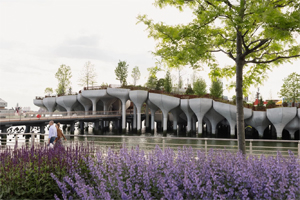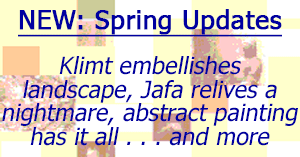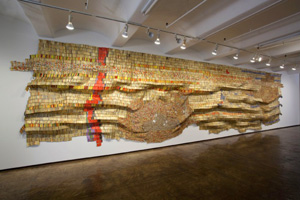7.11.25 — Climate and Devotion
Luana Vitra thinks of her work as “devotional offerings.” Is it too late to show her devotion to her African roots, her native Brazil, and the earth? And who is left to receive her offerings—apart from those who already enriched themselves on the former Congo? If Marina Zurkow is right, when it comes to the earth’s material resources, people were past caring long ago—and I work this together with recent reports on trees at Wave Hill as a look at art and climate change and my latest upload.
 Signs of recent life appear clearly enough with Zurkow at the Whitney, if not gods. A billboard still stands in a schematic but wonderfully detailed landscape. A picnic table has its place, too, right in the foreground, with a pond of sorts in the middle distance. Every so often, the sky teems with butterflies, lending their color to video’s artificial chill. People join them as well, in bear-fur blackface and comic yellow hazmat suits, and they better work fast. That pond is really a sinkhole, and a picnic, if any, would by now have already sunk.
Signs of recent life appear clearly enough with Zurkow at the Whitney, if not gods. A billboard still stands in a schematic but wonderfully detailed landscape. A picnic table has its place, too, right in the foreground, with a pond of sorts in the middle distance. Every so often, the sky teems with butterflies, lending their color to video’s artificial chill. People join them as well, in bear-fur blackface and comic yellow hazmat suits, and they better work fast. That pond is really a sinkhole, and a picnic, if any, would by now have already sunk.
The cast soon retires, leaving the blank billboard, an abandoned backyard grill, and a wintry landscapes. This is her Mesocosm—not a microcosm of devotional energy, but a middle ground where it might not be safe to kneel or to stand. Zurkow pairs it with The Earth Eaters, a second video still more dire in what it shows. An eruption every few seconds spills molten rock, roughly where the sinkhole has its dangers in Mesocosm. The real earth eaters are the humans who did the damage in extracting resources and leaving the rest to a dismal fate. Her animation has a cosmic and comic energy all the same.
It also has a sculptural counterpart just outside on the terrace, also through January 11, where Zurkow responds to the Whitney Museum site by the Hudson, much as her video responds to its source code. There The River Is a Circle, which sounds downright hopeful. A teardrop in shape, like the results of a map search, rises to a well-crafted wood bench. Naturally enough, though, no seating permitted, with or without a picnic. A sphere behind it echoes the science behind a buckyball by Buckminster Fuller, and blue tubes have their own charm and precision. The Whitney has its site-specific art, too, by David Hammons, in place of a former pier (just south of Barry Diller’s Little Island). Oh, the trade-offs in a return to earth.
For Vitra at SculptureCenter, the solution is simple. She can show her love for nature and its resources through her art, through July 28. A work titled Amulets should ward off harm, to humans or the earth, but here the curtains are light as feathers. Feathers cover the entrance wall, dyed a clear white and deep blue that should draw anyone closer to appreciate their art. The mineral dye, lapis lazuli, is from Brazil but perhaps better known from a poem named for it by William Butler Years.  Its color is at once sky blue and electric.
Its color is at once sky blue and electric.
It aims, in other words, to show both beauty and respect, like another offering to the gods. As Yeats wrote, “Every discolouration of the stone, / Every accidental crack or dent / Seems a water-course or an avalanche.” Minas Gerais, the place Vitra calls home, is rich in iron ore and other minerals, and she throws in both, in ceramics that morph into drum sets and towers into bowls for precious metals. Arrows point upward and outward as protection from further mining. White fabric wraps the whole, like bandages for a broken earth. More feathers produce a white curtain.
Sam Cottington and Alejandro Villabona have the small back room though June 9 for a slide show and performance, growing steadily in volume and determination to an anticlimactic standoff. Suffice it to say that its lovers do not get along. (It lost me.) Vitra by comparison may seem to avoid hard questions, but she takes due care to construct a proper offering. The installation winds its stately way through the gallery, as a tribute to her ancestors. To quote Yeats again, “Their ancient, glittering eyes, are gay.”
Read more, now in a feature-length article on this site.




